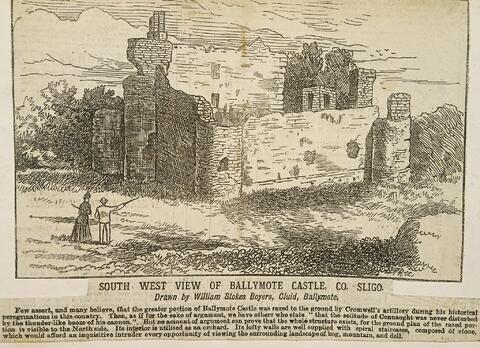Reference code
Title
Date(s)
- c.1895 (Creation)
Level of description
Extent and medium
1 p.; clipping
Name of creator
Repository
Archival history
Immediate source of acquisition or transfer
Scope and content
A clipping of an article on Ballymote Castle in County Sligo. The drawing is by William Stokes Boyers.
Appraisal, destruction and scheduling
Accruals
System of arrangement
Conditions governing access
Conditions governing reproduction
Language of material
Script of material
Language and script notes
Physical characteristics and technical requirements
Finding aids
Existence and location of originals
Existence and location of copies
Related units of description
Note
Built in the late twelfth century, the castle is an impressive Anglo-Norman fortification and one of the strongest fortresses of its era constructed in Connacht. It is believed to have been built by Richard de Burgh (c.1259-1326), 2nd Earl of Ulster, a friend of King Edward I (Edward Longshanks) of England, and one of the most powerful Norman lords of the period. As alluded to in the original caption, the castle has had a varied history of attack and destruction, changing hands several times between Gaelic clans and English forces.
It was from Ballymote that Aodh Ruadh Ó Domhnaill (Red Hugh O’Donnell) marched to the disastrous Battle of Kinsale in late 1601. It was subsequently surrendered to the victorious Crown forces under Charles Blount (Lord Mountjoy). In the seventeenth century, the castle was subjected to yet more military assaults and was finally abandoned in the 1690s. Over time, it fell into complete ruin. Ballymote Castle is now a designated national monument and is maintained by the Office of Public Works.

